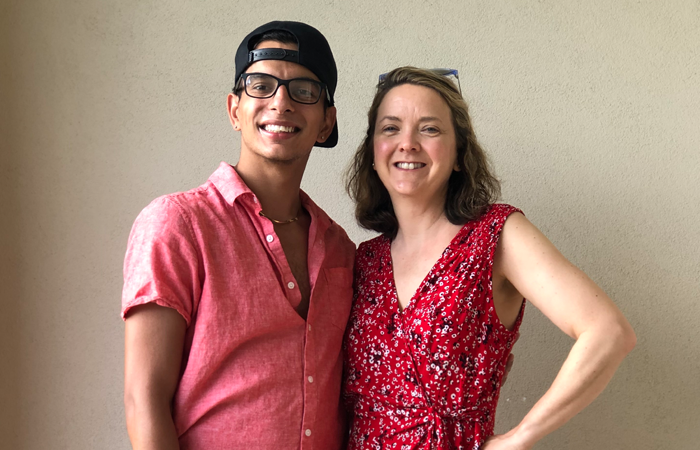Jane Crouth was frustrated — and tired. Her recently adopted toddler wouldn’t go to sleep. Uncomfortable with “crying it out” and co-sleeping methods, Crouth tried rocking her daughter to sleep. But as soon as she laid Ciara down and left the room, the child would wake up screaming.
After months of frustration, the Crouths decided to move Ciara in with her one-month-older brother. It worked. “She’s much more relaxed in the room with Owen,” says Crouth. “She quiets right down and relaxes.” Ah, if all sleep problems could be resolved so easily.
Many of us can relate to the Crouths’ difficulties. Studies indicate that 30 percent of all children have sleep problems. And anecdotal evidence suggests that sleep problems in adopted children are more common than in biological children, according to Todd Ochs, M.D., a clinical instructor of pediatrics at Northwestern University’s Feinberg School of Medicine in Chicago.
This isn’t surprising, considering what some children go through to enter their new families — the stress of life disruption, huge changes in their environment, even jet lag. “Each child’s resiliency varies,” says Dr. Ochs, an adoptive dad who runs an adoption clinic through his private pediatric practice. “Some kids hit the ground ready to go, while others need more time to adjust to their new family life.”
Scores of books and magazine articles offer sleep strategies to weary parents, but most of the literature doesn’t consider the unique factors that contribute to sleep problems in adopted children. Here, we look at the reasons for our children’s bedtime struggles, age by age, see how parents are conquering them, and offer specific advice from adoption experts.
Newborns and Infants
All parents of newborns struggle through the disruptions of multiple night feedings. After about four months, though, most babies are able to sleep through the night. But that doesn’t mean they will.
A version of Ferber. Kelly Vandergriff adopted her son, Landon, domestically when he was two hours old. The infant slept well until, at around age 8 months, he began waking up as soon as his mom or dad left the room. Vandergriff decided to try what she calls a “modified Ferber” approach.
The author of Solve Your Child’s Sleep Problems, Richard Ferber, M.D., may be the world’s best-known sleep expert. His approach to solving children’s sleep problems — known as “Ferberizing” — is that children must learn to fall asleep on their own under conditions that they can re-establish if they wake during the night. The strategy: Put your child to bed awake and leave the room.
If he cries, return to reassure him, but do not pick him up; if he continues to cry, return after progressively longer periods. The intended result: shorter and shorter periods of crying. Eventually your child will go to sleep on his own, and will do so again if he awakens later in the night. There are many variations of Ferber’s technique, collectively called “controlled crying.”
The first night Vandergriff tried her own variation, Landon cried for 20 minutes as she returned to reassure him every few minutes. The second night he cried for 10 minutes and then fell asleep. By the third night he was calm, falling asleep after seven minutes. He’s been sleeping through the night ever since. “He was reassured by our coming in, so I didn’t feel as though we were not there for him or attuned to his needs,” Vandergriff says.
Controlled-crying, with care. These techniques have proved to be effective sleep promoters. However, they should be used with adopted babies and children only after bonding has occurred and the child feels secure, advises pediatrician Sarah Springer, M.D., an adoptive mother and the director of International Adoption Health Services of Western Pennsylvania.
She suggests putting the child to bed when he is drowsy but not yet asleep. If the child wakes up, “don’t play and don’t pick him up.” she says. “Be as bland and as boring as you can when you go in to reassure him.” This conditions your child not to need you while showing that you are there for him when he calls.
The cry-it-out conundrum. A more extreme sleep strategy is the “cry it out” or “extinction” method promoted by Benjamin Spock, M.D., by which parents let the child cry and do not respond until morning. Sleep expert Marc Weissbluth, M.D., in his book, Healthy Sleep, Healthy Habits, recommends this as a last resort for babies and children who are extremely fussy or colicky or have difficult temperaments.
He admits that extinction seems harsh and difficult, but is effective. Dr. Ferber is not in favor of this method, citing its strain on parents and child, and most adoption experts would agree. “Children who are in the process of bonding cannot be permitted to cry it out,” says Dr. Ochs.
Babies and Toddlers
When a baby comes to a family at 9 months of age or older, sleep problems may arise because the child is used to sleeping in a certain environment and under certain conditions. Things may change dramatically with a placement, including subtle but disconcerting differences like smells and noises.
“An institutionalized child’s new home is often quieter than an orphanage filled with children,” says Mary Allen Staat, M.D., an adoptive mom and the director of the International Adoption Center at Cincinnati Children’s Hospital Center. There may also be the effect of travel, especially with a child from across the world.
Jane Crouth thinks that Ciara couldn’t sleep in a room alone because she had probably slept with her foster mother in China. Moving her in with her brother was an appropriate solution. Children who were never institutionalized may also have trouble falling and staying asleep if they’ve been rocked, held, or fed as they drifted off — what Dr. Ferber calls “wrong sleep associations.”
When stress plays out at night. The older a child gets, the more cognitive she becomes, and the more able to store experiences and memories in her brain. The degree of stress, even trauma, that adoption can bring depends on memories of her past experience (whether in an institution or not, whether well-cared-for or abused in some way) combined with the comprehension of her adoption experience (gradual or abrupt, amount of transition preparation, whether or not brought into a new culture with a new language).
A child’s reaction to such stress or trauma may be controlled by day, but released when she feels more vulnerable, as at night. Hence, the sleep problems so many adopted children experience.
Think of this age group as newborns in older bodies, suggests Dr. Springer. Many need constant reassurance that their parent is there for them, as a newborn does. “Be as physically and emotionally present as possible, but as briefly as the child will tolerate,” she says. Wean out nighttime visits very gradually.
In bed with Mom and Dad. Laurel VanDerWende tried a slew of recommended methods with her daughter, Crystal, from China. Crystal resisted falling asleep by screaming and thrashing about, and after falling asleep, would wake up every hour. What finally worked was “sleep-sharing” or “co-sleeping.” Now the VanDerWendes put Crystal to sleep in her own bed until they retire, then move her into their bed.
Sleep-sharing isn’t always having the child in bed with parents all night. It can also mean attaching a “sidecar” to an adult bed (often a crib with one side down, so the baby is within reach), having children sleep on the floor in the parents’ room, or having all family members sleep in separate beds in the same room. Some children co-sleep only during particularly stressful times or for only part of the night.
Advocates of sleep-sharing believe it allows children and parents to sleep better, helps babies thrive, and promotes trust between parents and child. Critics charge that the family bed is unsafe for infants and very young children, because a baby can become trapped between the bed and its frame or another object, can suffocate, or be rolled upon by a parent.
If a child is to co-sleep with parents, safety must be the primary concern, and parents must never retire while under the influence of drugs or alcohol. Overall, Dr. Springer finds co-sleeping acceptable as long as parents are in agreement about it and consider what they want later on. “If you don’t want to co-sleep long-term, do your sleep nurturing in your child’s room,” she says.
Panic in the night. Parents like VanDerWende often report that their children, adopted as toddlers, wake up screaming in the night. The operative words here are wake up. These children should be soothed. But some adoptive parents of toddlers and preschoolers report a different problem called “night terrors,” characterized by screaming, panic and fear, and sometimes the thrashing of limbs.
Night terrors are akin to sleepwalking or sleep-talking in that the child is not really awake and will have no memory of the episodes. Dr. Springer advises parents not to wake the child with night terrors, but to let the episode run its course. “It’s not indicative of a deeper pathology, although it’s very traumatic for the family,” she says.
Older Children
Older children bring cognitive and imaginative worries to bed with them that younger children and babies do not have. These can be exacerbated when a child comes to a new family at preschool age or older. Beyond the stress of their pre-adoption life and their placement, says Dr. Ochs, “Children may have irrational fears that their parents could die, or may assume blame for things that are not their fault.”
When worries wreck sleep. Kathryn Reiss’s daughter came from foster care at age 10 as a “riotous sleeper” — sleeping fitfully, thrashing around in bed, often waking totally turned around with the bedding all twisted. She also wet the bed. Reiss’s reaction was low-key and encouraging: “I never got annoyed with her. I just changed the sheets and told her she would stop when she felt more settled.” Indeed, the turmoil melted away when it became clear that the adoption would be finalized.
Bed-wetting is common, even for children who have not experienced trauma. “Don’t pressure kids,” says Dr. Staat. “Put them in pull-up diapers at night and forget about it. Most will overcome it in time.”
Easing into normalcy. A modified family bed helped when Ronda Evans’s daughter arrived from foster care at age 6. Anna was fearful at night due to traumas she had experienced, so a crib mattress was placed on the floor next to Ronda’s side of the bed. “We made it very matter-of-fact,” says Ronda. “We said that all of our kids did this, and we’ll know when you’re ready to move out.”
At first, Anna woke up afraid two or three times a night, and Evans would hold her hand until she went back to sleep. In about two months, Anna became acclimated and less fearful. Then she asked, “How come I’m the only one who sleeps on the floor in this family? Can I have my own bed in the girls’ room?” Now she shares a room with her sister and sleeps well.
Children who are preschool age and older when adopted may have experienced disturbing nighttime events in the past, including family arguments or physical or sexual abuse. Memories of these can cause trauma and lead to poor sleep. Dr. Springer emphasizes the importance of getting background information. “Parents who know their children’s history are in a better position to help them.” She also urges parents to demonstrate reliability by being available again and again.
Most parents can solve sleep problems in adopted children by being attuned to their child and his unique situation. If problems persist, it’s wise to consult your pediatrician to rule out medical causes, such as ear pain and sleep apnea. Don’t be afraid to try different approaches until you find the sleep technique that works. “It will be a process,” says Dr Ochs, “based on your child’s genetics, circumstances, and experiences.”
JOIN You are viewing this exclusive AF content as a guest. To access our full Adoption Parenting Library — plus digital issues, eBooks, expert audio and more — join Adoptive Families today.  |



